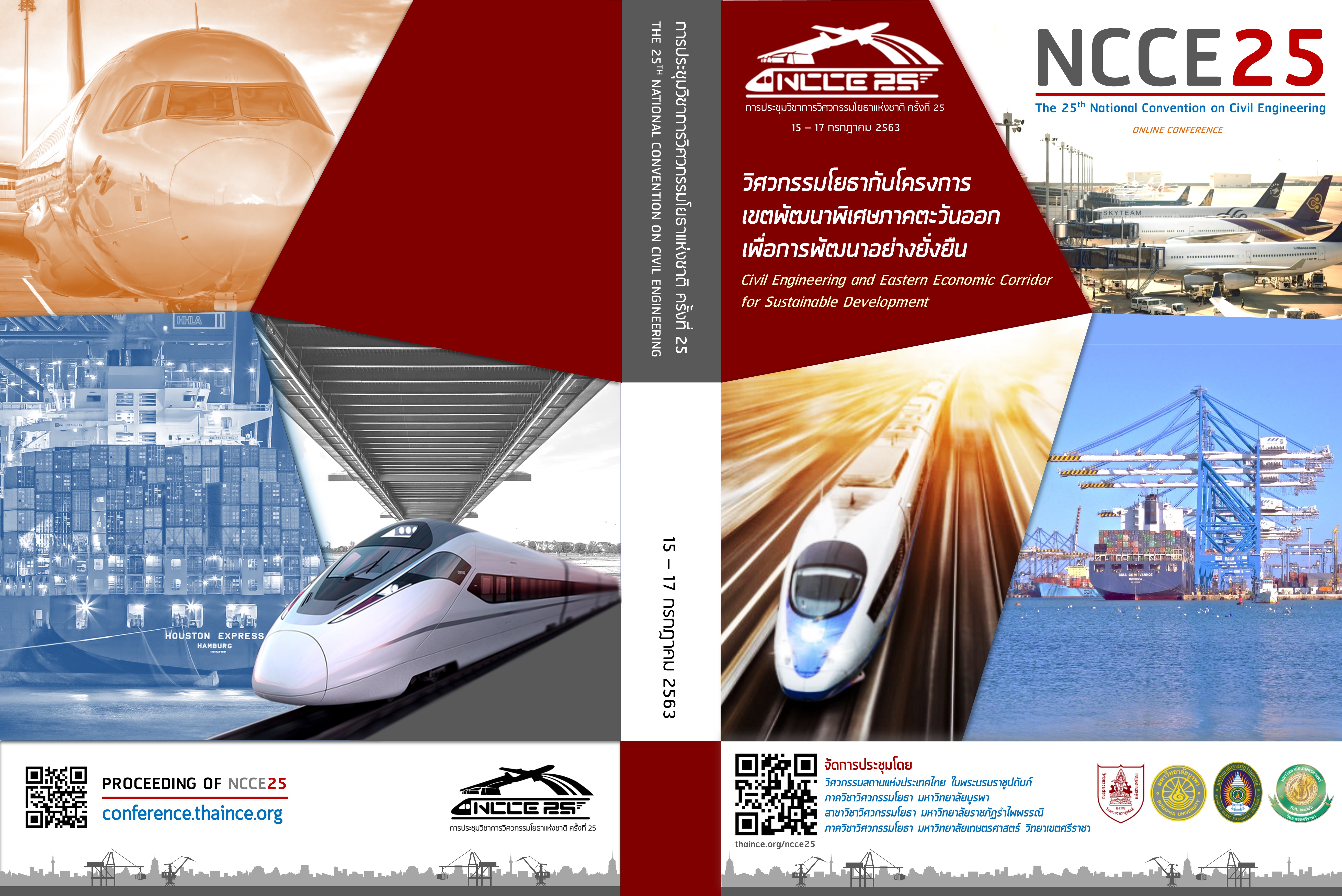Sustainability Indicators Review of Hemp Shiv as Alternative Materials for the Construction Industry in Thailand
Keywords:
Sustainable Construction, Eco-materials, Upcycling, Green Economy, Land Use Change, CO2 OffsetAbstract
Currently hemp is promoted worldwide for its many uses, however, in Thailand it is still limited and in the trial period. All parts of hemp can be utilized; the flowers, leaves and roots are used for medicinal and treatment purposes, food supplement, vitamins, etc. The stalk fibers are used in the fabric industry and are being researched for applications in the energy and other high-tech industries. The leftover stalk or hemp shiv is used as wood replacement or applied in the construction industry in various forms in countries where hemp is grown and used in the industrial scale but in Thailand they are still left as unmanaged or invaluable waste. Hemp shiv possesses characteristics of desirable construction materials in hempcrete and hemp concrete blocks replacing coarse aggregates. There are many researches on its abilities as wall materials showing that they have the potential of being used as non-load baring walls. However, the amount of hemp shiv required to sustain production will require land use change from edible to non-edible economic crop. This is very risky and the result may increase the vulnerability to the effects of Climate Change. Thus, the objective of this study is to assess the sustainability of hemp shiv as alternative materials for the construction industry in Thailand based on sustainability indicators on environment, social and economic impacts of industrial hemp and CO2 offset for using hemp as coarse aggregates and also to explore the economic feasibility and increased potential for upcycling hemp waste as construction products.
Downloads
References
[2] Huang, L., Krigsvoll., G., Johansen, F., Liu, Y., Zhang, X. (2018). Carbon emission of global construction sector. Renewable and Sustainable Energy Reviews, Elsevier, 81(P2), pp. 1906-1916.
[3] Madurwar, M. V., Ralegaonkar, R. V., Mandavgane, S. A. (2013). Application of agro-waste for sustainable construction materials: a review. Construction and Building Materials, 38, pp. 827-878.
[4] Raut, S. P., et al. (2011). Development of sustainable construction material using industrial and agricultural solid waste: A review of waste-create bricks. Construction and Building Materials, 25(10), pp. 4037-4042.
[5] Yilmaz, M., Bakiş, A. (2015). Sustainability in Construction Sector. Procedia-Social and Behavioural Science, 195, pp. 2253-2262.
[6] Colangelo, F., Forcina, A. et al (2018). Life cycle assessment (LCA) of different kind of concrete containing waste for sustainable construction. Buildings, 8(5), pp.70
doi: 10.3390/buildings8050070
[7] Panyakaew, S., Fotios, S. (2008). Agricultural Waste Materials as Thermal Insulation for Dewllings in Thailand: Preliminary Results. PLEA 2008-25th Conference on Passive and Low Energy Architecture, Dublin, Ireland, 22-24 October 2008.
[8] Gan, X., Zou, J., Ye, K., Skitmore, M., and Xiong, B. (2015). Why sustainable construction? Why not? An owner’s perspective. Habitat International, 47, pp. 61-68.
[9] Ferrer, A. L. C., Thomé, A. M. T., and Scavarda, A. J. (2018). Sustainable urban infrastructure: A review. Resources, Conservation and Recycling, 128, pp. 360-372.
[10] Karakoç., A. (2017). A Brief Review on Sustainability Criteria for Building Materials. JOJ Material Sci. 2(1): 555579. DOI: 10.19080/ JOJMS.2017.02.555579
[11] Khasreen, M. M., Banfill, P. F. G., and Menzies, G. F. (2009). Life-Cycle Assessment and the Environmental Impact of Buildings: A Review. Sustainability, 1, pp. 674-701.
[12] Liew, K. M., et al. (2017). Green concrete: Prospects and challenges. Construction and Building Materials, 156, pp. 1063-1095.
[13] Krizmane, M., et al. (2016). Key Criteria Across Existing Sustainable Building Rating Tools. Energy Procedia, 96, pp. 94-99.
[14] Nielsen, C. V. (2008). Carbon footprint of concrete buildings seen in the life cycle perspective. Concrete Technology Forum, Proceedings NRMCA 2008 June 2008, Denver, USA.
[15] Danso, H. (2018). Identification of Key Indicators for Sustaiable Construction Materials. Advances in Materials Science and Engineering, V2018, Article ID 6916258 https://doi.org/10.115/2018/6916258
[16] Pantawee, S., et al. (2017). Utilization of hemp concrete using hemp shiv as coarse aggregate with aluminium sulfate [Al2(SO4)3] and hydrated lime [Ca(OH)2] treatment. Construction and Building Materials, 156, pp. 435-442.
[17] Arrigoni, A., et al. (2017). Life cycle assessment of natural building materials: the role of carbonation, mixture components and transport in the environmental impacts of hempcrete blocks. Journal of Cleaner Production, 149, pp. 1051-1061.
[18] Florentin, Y., et al. (2017). A life-cycle energy and carbon analysis of hemp-lime bio- composite building materials. Energy and Buildings, 156, pp. 293-305.
[19] Dhakal, U., et al. (2017). Hygrothermal performance of hempcrete for Ontario (Canada) buildings. Journal of Cleaner Production, 142, pp. 3655-3664.
[20] Elfordy, S., et al. (2008). Mechanical and thermal properties of lime and hemp concrete (“hempcrete”) manufactured by a projection process. Construction and Building Materials, 22(10), pp. 2116-2123.
[21] Wahyuni, A. S., et al. (2014). The Performance of Concrete with Rice Husk Ash, Sea Shell Ash and Bamboo Fibre Addition. Procedia Engineering, 95, pp. 473-478.
[22] Pittau, F., et al. (2018). Fast-growing bio-based materials as an opportunity for storing carbon in exterior walls. Building and Environment, 129, pp. 117-129.
[23] Çomak, B., et al. (2018). Effects of hemp fibers on characteristics of cement based mortar. Construction and Building Materials, 169, pp. 794-799.
[24] Shahzad, A. (2013). A Study in Physical and Mechanical Properties of Hemp Fibres. Advances in Materials Science and Engineering, http://dx.doi.org/10.1155/2013/325085
[25] Ingrao, C. et al. (2015). Energy and environmental assessment of industrial hemp for building applications: A review. Renewable and Sustainable Energy Reviews, 51, pp. 29-42.
Downloads
Published
How to Cite
Issue
Section
License
บทความทั้งหมดที่ได้รับการคัดเลือกให้นำเสนอผลงานในการประชุมวิชาการวิศวกรรมโยธาแห่งชาติ ครั้งที่ 25 นี้ เป็นลิขสิทธิ์ของ วิศวกรรมสถานแห่งประเทศไทย ในพระบรมราชูปถัมภ์



